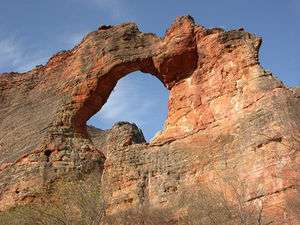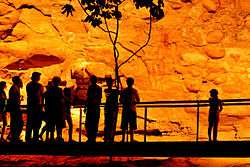Pedra Furada

Pedra Furada (Portuguese pronunciation: [ˈpɛdɾɐ fuˈɾadɐ], meaning pierced rock) is an important collection of over 800 archaeological sites in the state of Piauí, Brazil. These include hundreds of rock paintings dating from circa 11,000 years ago.[1] Charcoal from very ancient fires and stone shards that may be interpreted as tools suggest the possibility of a human presence prior to the arrival of Clovis people in North America.
In 1973, a Brazilian and French team excavating a site located in the southeastern portion of what is now the Serra da Capivara National Park discovered the first finds. The discovery was reported by the Brazilian archaeologist Niède Guidon, who published her findings in 1986.[2] She has since conducted extensive excavations and published other findings.
Excavations

Pedra Furada includes a collection of rock shelters used for thousands of years by human populations. The first excavations yielded charcoal deposits with Carbon-14 dates of 48,000 to 32,000 years BP. Repeated analysis has confirmed this dating, carrying the range of dates up to 60,000 BP.[3] A review of the site by archaeologist Tom Dillehay in 1994 suggested that the charcoal remains may have been from natural fires and were not necessarily indicative of human occupation.[4]
Guidon has established 15 distinct levels, classified in three cultural phases, called Pedra Furada, that includes the oldest remains; and Serra Talhada, from 12,000 to 7,000 BP, with tools such as knives, scrapers, flakes used "as is" or with some retouch and lithic cores, all made of quartz or quartzite. Third is Agreste late phase. The site also has hundreds of rock paintings dated from 5,000 to 11,000 years ago.[5]
More recently, the site of Toca da Tira Peia, also in Serra da Capivara National Park, was shown to have signs of human presence dating to 22,000 years ago.[6][7]
Also the nearby site of Sitio do Meio has been excavated over the years. Although not as old, in some ways it helps to support and clarify the chronology of Pedra Furada. The lithics at Sitio do Meio are better preserved.[8]
Significance

The discoveries are the subject of debate as they apparently contradict the longstanding "Clovis first" view for the settlement of humans in the Americas, which holds that the first inhabitants of the continent were representatives of the Clovis culture, which began roughly 11,500 BP.[9] Discoveries at other sites, such as Monte Verde, Chile, dated to 14,800 years BP, Piedra Museo in the Argentinian province of Santa Cruz, dated 11,000 years BP,[10] Topper in the state of South Carolina, U.S.A. dated 16,000–20,000 years BP,[11] and the Meadowcroft Rockshelter located near Avella in Washington County in southwestern Pennsylvania, United States, dated to 16,000 years BP, have also raised doubts about the "Clovis First" theory. As a result, scholars have proposed alternate scenarios for the routes of colonization and the diffusion of culture through the continents, in a heated dispute that has not been resolved.[12]
The mainstream view of the peopling of the Americas, also known as the short chronology theory, is that the first movement beyond Alaska into the New World occurred no earlier than 15,000 – 17,000 years ago, followed by successive waves of immigrants.[13][14] Pedra Furada provides potential evidence for the proponents of the long chronology theory, which states that the first group of people entered the hemisphere at a much earlier date, possibly 21,000–40,000 years ago,[15][16] with a much later mass secondary wave of immigrants.[17][18] This evidence is considered controversial and not widely accepted by experts in the field.[19][20] A caribou bone used as a scraper, found at the Old Crow Flats site in Canada was thought to be 27,000 years old in the 1970s was used to support the long chronology theory. A re-dating, with more modern techniques in the 1990s came up with an age of 2,000 years.[21]
Controversy
Debate continues as to whether or not the artifacts and hearths are instead geofacts that were made naturally, or alternatively, made by monkeys. Wild bearded capuchin monkeys (Sapajus libidinosus) in Serra da Capivara National Park have been observed smashing stones against rocks embedded in the ground. The resulting 'shaped' rocks and flakes are similar to early hominid tools and flakes. It has been suggested that similar behavior, by earlier simians, might account for what have been regarded as human tools at Pedra Furada. James Adovasio of Florida Atlantic University believes that the tools identified by Guidon as human made are rocks that fell from a cliff and broke when they hit the ground. “The Pedra Furada stuff is not even up to capuchin standards,” he said. (The capuchin behavior also has implications for interpretations of the simplest Oldowan technology in East African).[22][23][24][25] This seems to be a dividing line on the debate among archaeologists disputing Guidon's theory that the site's artifacts prove pre-Clovis human settlement in the Americas.
In 2000 the controversy was characterized by Alex Bellos, at The Guardian, as U.S. archaeologists believe that the items are geofacts created naturally, "because the North Americans cannot believe that they do not have the oldest site", while David Meltzer, of the Southern Methodist University in Dallas, Texas asks "...if we have [pre-Clovis] humans in South America, then by golly, why don't we have them in North America too?"
Responding to this Guidon suggested a sea voyage across the Atlantic as a potential route for the first migration.[26]
In an article in the New York Times Guidon claimed occupation of the Americas could go back 100,000 years and the first settlers 'might have come not overland from Asia but by boat from Africa'.
Michael R. Waters, a geoarchaeologist at Texas A&M University noted the absence of genetic evidence in modern populations to support Guidon's claim.[27] The Buttermilk Creek Complex in Texas was discovered in 2006 and dated at about 15,500 BP. [28]
Then, in 2017 a hearth excavated on Triquet Island off British Columbia was determine to be 14,000 years old, making it one of the oldest human settlements ever discovered in North America and bolstering the Pacific Coastal Migration route hypothosis.[29]
Guidon has said that, "The carbon is not from a natural fire. It is only found inside the sites. You don't get natural fires inside the shelters."[26] French palaeolithic archaeologist Jacques Pelegrin, believes there is a possibility for natural processes creating flaked stones that could mimic the Pedra Furada specimens because of their simplicity, but he finds this very unlikely in this case because of continuous human presence in the site.[30]
See also
| Wikimedia Commons has media related to Pedra Furada (Serra da Capivara). |
| Wikimedia Commons has media related to Cave art in Serra da Capivara National Park. |
References
- ↑ Bradshaw Foundation
- ↑ Guidon, Niède y G. Delibrias (1986). "Carbon-14 dates point to man in the Americas 32 000 years ago". Nature (321): 769–771. doi:10.1038/321769a0.
- ↑ Guidon, Niède. 1986 "Las Unidades Culturales de Sao Raimundo Nonato – Sudeste del Estado de Piaui-Brasil"; New Evidence for the Pleistocene Peopling of the Americas: 157–171. Edited by Alan Bryan. Center for the Study of Early Man. University of Maine. Orono.
- ↑ Meltzer, David; Adovasio, James; Dillehay, Tom (1 December 1994). "On a Pleistocene human occupation at Pedra Furada, Brazil". Antiquity. Retrieved 20 January 2015.
- ↑ "Pedra Furada, Brazil: Paleoindians, Paintings, and Paradoxes: An interview with Drs. Niède Guidon, Anne-Marie Pessis, Fabio Parenti, Claude Guérin, Evelyne Peyre, and Guaciara M. dos Santos"
- ↑ "Disputed Finds Put Humans in South America 22,000 Years Ago". Science Magazine. 20 April 2013.
- ↑ Lahaye, Christelle; Hernandez, Marion; Boëda, Eric; Felice, Gisele D.; Guidon, Niède; Hoeltz, Sirlei; Lourdeau, Antoine; Pagli, Marina; Pessis, Anne-Marie; Rasse, Michel; Viana, Sibeli (2013). "Human occupation in South America by 20,000 BC: the Toca da Tira Peia site, Piauí, Brazil". Journal of Archaeological Science. 40 (6): 2840–2847. doi:10.1016/j.jas.2013.02.019. ISSN 0305-4403.
- ↑ AIMOLA, Giulia et al. Final Pleistocene and Early Holocene at Sitio do Meio, Piauí, Brazil: Stratigraphy and comparison with Pedra Furada. Journal of Lithic Studies, [S.l.], v. 1, n. 2, p. 5-24, sep. 2014. ISSN 2055-0472. Available at: <http://journals.ed.ac.uk/lithicstudies/article/view/1125/1631>. Date accessed: 16 Apr. 2016 doi:10.2218/jls.v1i2.1125
- ↑ Oppenheimer, Stephen (2011). "Clovis First: Shaking the Orthodoxy". Bradshaw Foundation. Retrieved 20 January 2015.
- ↑ Paleoamerican Origins, Smithsonian, http://www.smithsonian.org/encyclopedia_si/nmnh/origin.htm
- ↑ Goodyear, Albert C. (1 January 2005). "Evidence of Pre-Clovis Sites in the Eastern United States". Scholar Commons. University of South Carolina. Retrieved 20 January 2015.
- ↑ Whitely, David S.; Dorn, Ronald I (October 1993). "New Perspectives on the Clovis vs. Pre-Clovis Controversy" (PDF). American Antiquity. Retrieved 20 January 2015.
- ↑ "Chaw joins poop in archaeology arsenal". University of Wisconsin.
- ↑ Axelrod, Alan (2003). The Complete Idiot's Guide to American History. Alpha Books. ISBN 0-02-864464-6. Retrieved 5 February 2010.
- ↑ "Introduction". Government of Canada. Parks Canada. 2009. Archived from the original on 24 April 2011. Retrieved 9 January 2010.
Canada's oldest known home is a cave in Yukon occupied not 12,000 years ago like the U.S. sites, but at least 20,000 years ago
- ↑ "Pleistocene Archaeology of the Old Crow Flats". Vuntut National Park of Canada. 2008. Archived from the original on 22 October 2008. Retrieved 10 January 2010.
However, despite the lack of this conclusive and widespread evidence, there are suggestions of human occupation in the northern Yukon about 24,000 years ago, and hints of the presence of humans in the Old Crow Basin as far back as about 40,000 years ago.
- ↑ "Atlas of the Human Journey". National Geographic.
- ↑ "Journey of mankind". Brad Shaw Foundation.
- ↑ "Pedra Furada". Encyclopædia Britannica. Retrieved 20 January 2015.
- ↑ "Pedra Furada". Journey To A New Land. SFU Museum of Archaeology and Ethnology. 2005. Retrieved 20 January 2015.
- ↑ Zazula, Grant; Froese, Duane (2013). "Ice Age Old Crow" (PDF). Government of Yukon. Archived from the original (PDF) on 2013-11-06. Retrieved 30 January 2018.
- ↑ Wong, Kate. "Whose Tools Are These?". Scientific American. 316 (1): 10–12. doi:10.1038/scientificamerican0117-10.
- ↑ Wong, Kate. "Wild Monkeys' Stone "Tools" Force a Rethink of Human Uniqueness". Scientific American. Retrieved 2018-01-30.
- ↑ Handwerk, Brian. "Wild Monkeys Unintentionally Make Stone Age Tools, But Don't See the Point". Smithsonian. Retrieved 2018-01-30.
- ↑ Proffitt, Tomos; Luncz, Lydia V.; Falótico, Tiago; Ottoni, Eduardo B.; Torre, Ignacio de la; Haslam, Michael (3 November 2016). "Wild monkeys flake stone tools". Nature. 539 (7627): 85–88. doi:10.1038/nature20112. ISSN 1476-4687.
- 1 2 "Brazilian Findings Spark Archeological Debate" by Alex Bellos
- ↑ Romero, Simon (2014-03-27). "Discoveries Challenge Beliefs on Humans' Arrival in the Americas". The New York Times. ISSN 0362-4331. Retrieved 2018-01-29.
- ↑ , “Science”
- ↑ , “Smithsonian”
- ↑ David Meltzer, "Stones of contention", New Scientist
Bibliography
AIMOLA, Giulia et al. Final Pleistocene and Early Holocene at Sitio do Meio, Piauí, Brazil: Stratigraphy and comparison with Pedra Furada. Journal of Lithic Studies, [S.l.], v. 1, n. 2, p. 5-24, sep. 2014. ISSN 2055-0472. Available at: <http://journals.ed.ac.uk/lithicstudies/article/view/1125/1631>. Date accessed: 16 Apr. 2016 doi:10.2218/jls.v1i2.1125
External sites
- The rock art of Pedra Furada bradshawfoundation.com
- Serra Da Capivara on Pinterest.com